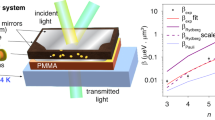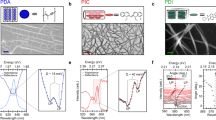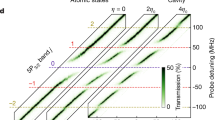Abstract
Cavity polaritons, the elementary optical excitations of semiconductor microcavities, may be understood as a superposition of excitons and cavity photons1. Owing to their composite nature, these bosonic particles have a distinct optical response, at the same time very fast and highly nonlinear. Very efficient light amplification due to polariton–polariton parametric scattering has recently been reported in semiconductor microcavities at liquid-helium temperatures2,3,4,5,6,7,8,9,10,11. Here we demonstrate polariton parametric amplification up to 120 K in GaAlAs-based microcavities and up to 220 K in CdTe-based microcavities. We show that the cut-off temperature for the amplification is ultimately determined by the binding energy of the exciton. A 5-µm-thick planar microcavity can amplify a weak light pulse more than 5,000 times. The effective gain coefficient of an equivalent homogeneous medium would be 107 cm-1. The subpicosecond duration and high efficiency of the amplification could be exploited for high-repetition all-optical microscopic switches and amplifiers. 105 polaritons occupy the same quantum state during the amplification, realizing a dynamical condensate of strongly interacting bosons which can be studied at high temperature.
This is a preview of subscription content, access via your institution
Access options
Subscribe to this journal
Receive 51 print issues and online access
$199.00 per year
only $3.90 per issue
Buy this article
- Purchase on Springer Link
- Instant access to full article PDF
Prices may be subject to local taxes which are calculated during checkout




Similar content being viewed by others
References
Weisbuch, C., Nishioka, M., Ishikawa, A. & Arakawa, Y. Observation of the coupled exciton-photon mode splitting in a semiconductor quantum microcavity. Phys. Rev. Lett. 69, 3314–3317 (1992).
Savvidis, P. G. et al. Angle-resonant stimulated polariton amplifier. Phys. Rev. Lett. 84, 1547–1551 (2000).
Ehrenstein, D. Amplifier from half-breed particles. Phys. Rev. Focus 5, story 6 (2000).
Yamamoto, Y. Half-matter, half-light amplifier. Nature 405, 629–630 (2000).
Ciuti, C., Schwendimann, P., Deveaud, B. & Quattropani, A. Theory of the angle-resonant polariton amplifier. Phys. Rev. B 62, R4825–R4828 (2000).
Dasbach, G., Baars, T., Bayer, M., Larionov, A. & Forchel, A. Coherent and incoherent polaritonic gain in a planar semiconductor microcavity. Phys. Rev. B 62, 13076–13083 (2000).
Houdré, R., Weisbuch, C., Stanley, R. P., Oesterle, U. & Ilegems, M. Nonlinear emission of semiconductor microcavities in the strong coupling regime. Phys. Rev. Lett. 85, 2793–2796 (2000).
Stevenson, R. M. et al. Continuous wave observation of massive polariton redistribution by stimulated scattering in semiconductor microcavities. Phys. Rev. Lett. 85, 3680–3683 (2000).
Savvidis, P. G. et al. Asymmetric angular emission in semiconductor microcavities. Phys. Rev. B 62, R13278–R13281 (2000).
Baumberg, J. J. et al. Parametric oscillation in a vertical microcavity: a polariton condensate or micro-optical parametric oscillation. Phys. Rev. B 62, R16247–R16250 (2000).
Ciuti, C., Schwendimann, P. & Quattropani, A. Parametric luminescence of microcavity polaritons. Phys. Rev. B 63, 041303R-1–041303R-4 (2001).
Imamoglu, A., Ram, R. J., Pau, S. & Yamamoto, Y. Nonequilibrium condensates and lasers without inversion: exciton-polariton lasers. Phys. Rev. A 53, 4250–4253 (1996).
Huang, R., Tassone, F. & Yamamoto, Y. Experimental evidence of stimulated scattering of excitons into microcavity polaritons. Phys. Rev. B 61, R7854–R7857 (2000).
Le Si, Dang, Heger, D., André, R., Boeuf, F. & Romestain, R. Stimulation of polariton photoluminescence in semiconductor microcavity. Phys. Rev. Lett. 81, 3920–3923 (1998).
Bloch, J., Freixanet, T., Marzin, J. Y., Thierry-Mieg, V. & Planel, R. Giant Rabi splitting in a microcavity containing distributed quantum wells. Appl. Phys. Lett. 73, 1694–1696 (1998).
Kelkar, P. V. et al. Stimulated emission, gain and coherent oscillations in II-VI semiconductor microcavities. Phys. Rev. B 56, 7564–7573 (1997).
Ponce, F. A. & Bour, D. P. Nitride-based semiconductors for blue and green light-emitting devices. Nature 386, 351–359 (1997).
Pearton, S. J., Zolper, J. C., Shul, R. J. & Ren, F. GaN: processing, defects, and devices. J. Appl. Phys. 86, 1–78 (1999).
Lidzey, D. G. et al. Strong exciton–photon coupling in an organic semiconductor microcavity. Nature 395, 53–56 (1998).
Lidzey, D. G., Bradley, D. D. C., Armitage, A., Walker, S. & Skolnick, M. S. Photon-mediated hybridisation of Frenkel excitons in organic semiconductor microcavities. Science 288, 1620–1623 (2000).
Acknowledgements
We thank U. Oesterle and R. Houdré for growing the InGaAs sample, and J.D. Ganiere, G. Hayes, A. Quattropani, R. Romestain, P. Senellart and P. Schwendimann for suggestions. This work has been supported in part by the Fonds National Suisse de la Recherche Scientifique.
Author information
Authors and Affiliations
Corresponding author
Rights and permissions
About this article
Cite this article
Saba, M., Ciuti, C., Bloch, J. et al. High-temperature ultrafast polariton parametric amplification in semiconductor microcavities. Nature 414, 731–735 (2001). https://doi.org/10.1038/414731a
Received:
Accepted:
Issue Date:
DOI: https://doi.org/10.1038/414731a
This article is cited by
-
Nonlinear polariton parametric emission in an atomically thin semiconductor based microcavity
Nature Nanotechnology (2022)
-
Polariton condensation and surface enhanced Raman in spherical ZnO microcrystals
Nature Communications (2020)
-
Direct Interbranch Relaxation of Polaritons in a Microcavity with Embedded CdSe/(Cd,Mg)Se Quantum Wells
Journal of Electronic Materials (2020)
-
A room-temperature organic polariton transistor
Nature Photonics (2019)
-
Giant optical nonlinearities from Rydberg excitons in semiconductor microcavities
Nature Communications (2018)
Comments
By submitting a comment you agree to abide by our Terms and Community Guidelines. If you find something abusive or that does not comply with our terms or guidelines please flag it as inappropriate.



